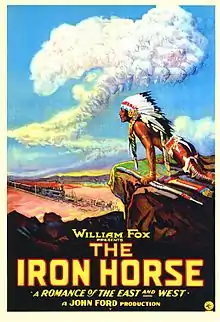The Iron Horse (film)
The Iron Horse is a 1924 American silent Western film directed by John Ford and produced by Fox Film.[1] It was a major milestone in Ford's career, and his lifelong connection to the western movie genre. It was Ford's first major film, in part because the hastily planned production went over budget, as Fox was making a hurried response to the success of another studio's western. In 2011, this film was deemed "culturally, historically, or aesthetically significant" by the United States Library of Congress and selected for preservation in the National Film Registry. [2]
| The Iron Horse | |
|---|---|
 Film poster | |
| Directed by | John Ford (uncredited) |
| Produced by | John Ford |
| Written by | Charles Kenyon John Russell Charles Darnton |
| Starring | George O'Brien Madge Bellamy |
| Music by | Ernö Rapée (uncredited) |
| Cinematography | George Schneiderman |
| Edited by | Hettie Gray Baker |
| Distributed by | Fox Film Corporation |
Release date |
|
Running time | 150 minutes (US version) 133 minutes (International version) |
| Country | United States |
| Language | Silent (English intertitles) |
| Budget | $280,000 |
| Box office | $2,000,000 |
Plot
The film is about the construction of the American first transcontinental railroad. It depicts Irish, Italian, and Chinese immigrants, as well as African Americans, as the men who did the backbreaking work that made this feat possible. The primary villain is an unscrupulous businessman who masquerades as a renegade Commanche. It culminates with the scene of driving of the golden spike at Promontory Summit on May 10, 1869. There is a note in the title before this scene that the two original locomotives from the 1869 event are used in the film, although this is false - both engines (Union Pacific No. 119 and Jupiter) were scrapped before 1910. Main stars were George O'Brien and Madge Bellamy.
Cast
- George O'Brien as Davy Brandon
- Madge Bellamy as Miriam Marsh
- Charles Edward Bull as Abraham Lincoln
- Cyril Chadwick as Peter Jesson
- Will Walling as Thomas Marsh
- Francis Powers as Sergeant Slattery
- J. Farrell MacDonald as Corporal Casey
- Jim Welch as Private Schultz / Mackay (credited as James Welch)
- George Waggner as Col. William F. 'Buffalo Bill' Cody
- Fred Kohler as Deroux / Bauman
- James A. Marcus as Judge Haller (credited as James Marcus)
- Gladys Hulette as Ruby
- Chief John Big Tree as Cheyenne Chief (uncredited)
Legacy
In December 2011, The Iron Horse was selected for inclusion in the Library of Congress' National Film Registry.[3] In choosing the film, the Registry said that The Iron Horse "introduced to American and world audiences a reverential, elegiac mythology that has influenced many subsequent Westerns."[3]
Among the extras used in the Central Pacific sequences were several Chinese men playing coolies who worked on the railroad. They were in fact retired Central Pacific Railroad employees who had helped build the first transcontinental railroad through the Sierras, who came out to participate in the filming as a lark.[4]
The film is recognized by American Film Institute in the following list:
- 2008: AFI's 10 Top 10: Nominated Western Film[5]
Critical reception
The film has a 78% rating in Rotten Tomatoes.[6]
Home media
The film was released on DVD in America in its full-length US version (accompanied by the truncated UK version). A 2011 release of The Iron Horse on DVD in the UK included both the US and International/UK versions of the picture, and a half-hour video-essay about the film by author and critic Tag Gallagher. The 'international' version includes some variant shots and uses different names for some supporting characters; it also carries a dedication to the British railway engineer George Stephenson.[7]
Near the end of the film, it is stated that the actual "Jupiter" and "UP 116" were used in the scene. Besides incorrectly identifying the "UP 119" as the "UP 116", both engines had been scrapped 21 and 15 years earlier. Of interest, however, what appears to be the Central Pacific's "C.P. Huntington", now on display in Sacramento, California, is being manhandled up a steep grade on a sledge made of logs.
Novelization
Starting in the early 1920s the publishing house Grosset and Dunlap crafted a deal with the prominent Hollywood studios to issue novelizations of their major, original releases and among those was The Iron Horse (1924, 329pp). The author was Edwin C. Hill, then a journalist, who would become a prominent radio broadcaster, best remembered for a show called The Human Side of the News.
See also
References
- "Progressive Silent Film List: The Iron Horse". Silent Era. Retrieved March 1, 2008.
- "Complete National Film Registry Listing | Film Registry | National Film Preservation Board | Programs at the Library of Congress | Library of Congress". Library of Congress, Washington, D.C. 20540 USA. Retrieved May 1, 2020.
- "2011 National Film Registry More Than a Box of Chocolates". Library of Congress. December 28, 2011. Retrieved December 29, 2011.
- Brownlow, Kevin. Episode "Out West," Hollywood: A Celebration of American Silent Cinema (Thames Television), 1980
- "AFI's 10 Top 10 Nominees" (PDF). Archived from the original (PDF) on July 16, 2011. Retrieved August 19, 2016.
- https://www.rottentomatoes.com/m/1188234_iron_horse
- The Iron Horse: 2011 DVD edition, The Masters of Cinema Series.
External links
| Wikimedia Commons has media related to The Iron Horse (film). |
- The Iron Horse essay by David Kiehn on the National Film Registry website
- The Iron Horse at IMDb
- The Iron Horse on Amazon Prime Video